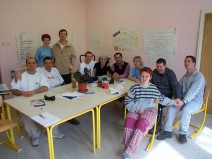LIST OF ARTICLES
|
STUDY CIRCLES: a different way of learning a language
INTRODUCTION What is a study circle?
Basically it is any group of people who study together. It is a very popular way for adults to learn any subject in Scandinavia and Slovenia, where the idea is a little more formalised, but study circles for language learning are unusual even there. The emphasis in a study circle is strongly on what the learners want to achieve themselves, rather than on what a teacher says they need.
HOW DOES A STUDY CIRCLE WORK?
The main difference from a traditional class is that it is the members of the group who decide what they want to learn and how. They agree on when, how often and where the group will meet. They decide, probably in discussion with the mentor and always in discussion with one another, what they will learn, what resources they will use and what approaches they will try to adopt.
The group does not have a formal teacher, although they may use one at times. This could be the mentor, another member of the group, or someone asked in [and paid ?] on particular occasions.
The mentor or facilitator may or may not be a member of the group. He/she helps the group to stay together and learn, but his or her role varies from group to group, from that similar to a teacher, to that of an advisor called on only when required.
Everyone contributes in their own way to the group. For example, some of the ways might be to:
Book the meeting room and arrange refreshments
Let absentees know about homework and the next meeting
Draw up a list of questions which members needed help with
Explain a learning point that was causing difficulty
Devise some activities or puzzles for the next meeting
Contact a teacher to come to some sessions to teach
Look for some learning resources
Members of the group support one another, so that people who are at different stages of learning can be accommodated in the group.
The group sets itself some goals. These may be about what they will learn and/or what they will do with it. For example in a language group they might decide:
‘ By Christmas we will all be able to introduce ourselves in the new language.
Then we’ll sent some information about the group to some colleagues abroad by e-mail.’
Goals should be definite but not too rigid. In the example above, introducing oneself could be at different levels for different members.
WHAT ARE THE FACTORS WHICH MAKE A LANGUAGE STUDY CIRCLE SUCCESSFUL?
These are not easy to specify, as each group is unique, but some of these points seem to be important.
New ways of learning, for example, the wealth of resources on the Internet, make studying without a teacher more possible these days. But studying alone can be difficult when learning a language. This approach provides support without too much formal teaching.
Adults bring lots of previous experience to any new learning opportunity. They already know how they themselves learn best and probably have definite ideas about what and why they are learning. This background can be a good starting point.
In a group, however, there has to be discussion and eventually some agreement, and this process may offer opportunities for ideas to be developed and changed.
Adults are usually busy people and the possibility of having a flexible learning timetable can be very useful for them. [For example, the group could decide to meet twice a week for 20 minutes, or for 3 hours once a month!] How about meeting in the pub from time to time, or seeing a foreign film together?
The ‘group dynamic’ is very important and can make or break a group. It also may take a surprisingly long time for a group to gel. It is important that everyone tries to have the confidence to express their opinions and that nobody dominates the others.
It is useful to have someone, possibly the mentor, who can give informed advice on resources and methods of language learning, as it is a little more specialised than in some subjects. The members then need to find out by experience what works for them.
It is important to remain flexible about any decisions made. For example you may need to change how often you meet, or look for a more suitable course, or try new methods of learning.
Some good audio resources are essential to ensure correct pronunciation.
Good luck with your study circle. Please let us know how you get on.
|

|
|
Jenny Norris
Manager
The ALLEGRO Project
School of Arts, Communication and Culture
Nottingham Trent University |